| Welcome
to the first issue of e-Tutorial, the on-line help to Econ 508. The introductory
material presented below is the first of a series of handouts that will
be distributed along the course, designed to enhance your understanding
of the topics and your performance on the homework. This very first
issue focuses on the basic operations of the main software used in the
course (STATA). The core material was extracted from Gregory Kordas' "Computing
in Econ 472" (1999) and "A Tutorial in Stata" (1999). The usual
disclaimers apply.

Accessing
Stata
The statistical
package Stata can be found at the OCSS (Office of Computing and Communications
for Social Sciences) lab, located at the 212 Lincoln Hall. Also, you can find Stata at the Foreign Languages Building (FLB) (room G8). It is also available
at the Econometrics Lab, DKH, for students enrolled in the Econometrics
field or other classes that require lab experiments.
STATA has
an extraordinary set of reference books, and by this reason some students
may be interested in purchasing the package. In those cases, the best strategy
is to form a group of students and make a special order to STATA Inc. For
Econ 508 purposes, however, the weekly edition of e-Tutorial will bring
all necessary information to solve the homework.
Downloading
Data
The first
step required to solve the homework is to download the respective data
sets. Usually the data will be posted in the ASCII or text formats.
In order to work with the data, I suggest the following steps:
a) Go to
the web page containing the data, and save it in a floppy disk or a hard
drive. If the latter is chosen, I suggest you create a directory exclusively
dedicated to Econ508 materials.
b) After
saving, go to STATA and infile the data in its original format.
c) Finally,
save the data in the format .dta, adopted by STATA.
Example
- The U.S. Economy in the 1990s
Let's start
with an analysis of the performance of the U.S. economy during the 1990s.
I have collected annual data on GDP growth, GDP per capita growth, private
consumption growth, investment growth, manufacturing labor productivity
growth, unemployment rate, and inflation rate. The first two variables
can be seen as dependent variables, and you should test whether they are
close substitutes or the population size has dramatically changed during
this period. Consumption, investment, and productivity can be seen as factors
that enhance GDP growth, and therefore you should expect positive covariates
for those variables. Finally, unemployment and inflation rates are intrinsically
correlated, and you should check whether any (or both) can be included
in our simplistic growth model.
Please click
here
to access the data in a text format. After data, save as recommended, and
go to the Stata Command window. There, please type the following command:
infile
year gdpgr consgr invgr unemp gdpcapgr inf producgr using "a:\US90.txt"
(I assumed
that you have saved the data set in a floppy disk and the file has .txt
extension. If the file has a .raw format or you wish to save it in a different
location, just repeat the command above doing the respective adjustments
(i.e., including your preferred directory and changing file extension).
For ASCII data with .raw format, you can omit the extension. E.g.:
infile
year gdpgr consgr invgr unemp gdpcapgr inf producgr using "c:\Econ472\US90"
In the commands
above, the term "ïnfile" refers to the action executed by Stata, the
terms "gdpgr, ..., producgr" correspond to the name of the respective variables
according to the order they appear in the data set, and the rest of the
command describes the location you have chosen to save the downloaded data.
After that, you can visualize your data using the button "Data Editor"
in the toolbar. The final step is to save the file in a Stata format, with
the extension .dta. Now you are ready to work with your data!!
Basic Operations
A useful
way to explore your data is checking the main statistics of each variable.
For example, in the Stata Command window you can obtain the minimum, maximum,
arithmetic mean, and standard deviation of each variable in your data set
by typing
summarize
Variable
| Obs
Mean Std. Dev. Min
Max
---------+-----------------------------------------------------
year | 11
1997 3.316625 1992
2002
gdpgr | 11 3.463636
1.050974 1.5
5
consgr | 11 3.645455
1.03476 2.4
5.3
invgr | 11 6.954545
2.408885 3.3
10.7
unemp | 11 5.327273
1.125247 4
7.5
gdpcapgr
| 11 2.490909
1.048289 .7
4.2
inf | 11 2.590909
.5204893 1.5
3.4
producgr
| 11 4.309091
1.590883 1.9
7.2
If you also
wish to know the behavior along the percentiles, type
summarize,
detail
If you are
only interested in a single variable, just include its name after the command
summarize
gdpgr, detail
If you are
only interested in a subset of your data, you can inspect it using filters.
E.g., if you are only interested in the years of the Clinton administration,
you type
summarize
if year>=1993 & year<=2000
And then you
can contrast that period with the family Bush administrations
summarize
if year<1993 | year>2000
You may also
check all years but the election years, to avoid political cycles:
summarize
if year~= 2000 & year~=1996 & year~=1992
At this point
you have already noticed the main logical operators in Stata:
>=
means "greater or equal",
<=
means "less or equal",
&
means "and",
|
means "or".
The arithmetic
operators are as usual (+, -, *, /). And to create a new variable
using them, you can do as follows: Suppose you wish to know how close the
GDP growth is to the GDP per capita growth. So, you create a ratio of those
two variables, and check it:
generate
gdpratio= gdpgr/ gdpcapgr
summarize
gdpratio, detail
The same procedure
can be done to obtain traditional transformations, such as
squares:
gen produc2=producgr^2
square
roots: gen infroot=sqrt(inf)
exponential:
gen expgdpgr=exp(gdpgr)
natural
logs: gen logunemp=log(unemp) or simply
gen lnunemp=ln(unemp)
base 10
logs: gen log10inf=log10(inf)
A final remark
is that you should choose a name for the generated variable with at most
8 characters, otherwise the system will give an error message. Nevertheless,
you can always describe your variables in more details using the commands
label or notes. Last, but not least, the Help toolbar contains short but
useful information on the main commands. It does not hurt visit it once
in a while...
Exploring
Graphical Resources
Suppose now
you want to check the relationship among variables. For example, you want
to see how much consumption and investment are correlated with GDP (all
variables in growth rates). The command for that is:
graph
gdpgr consgr invgr year
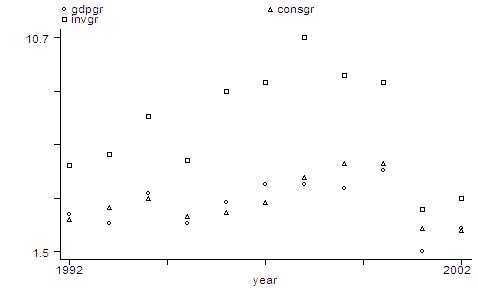
The output
is a scatter of points for each series, with the investment series being
relatively higher than the other two series. If you are more interested
on the dynamics of the series than in the levels, you can re-scale the
graph and connect the points. The command is as follows:
graph
gdpgr consgr invgr year, rescale c(lll)
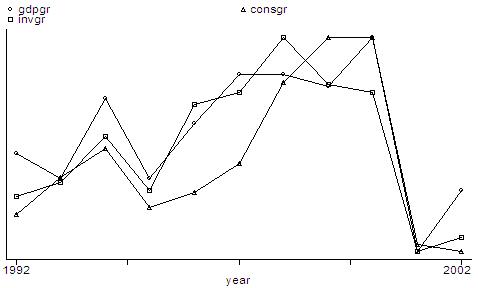
In the command
above, "rescale" allows the shift on the series, and "c(lll)" connects
the points using lines for each series. Many other graph types are available
in STATA, and you can explore them as necessary. In this brief intro, the
following commands will be useful:
* to extract
the symbols on the series:
graph
gdpgr consgr invgr year, rescale c(lll) symbol(iii)
* to give
a title to the graph:
graph
gdpgr consgr invgr year, c(lll) b1(Figure 1. GDP, Consumption and Investment)
b2(year) l2(growth rate)
* to plot
only specific ranges:
graph
gdpgr consgr invgr year if year>=1993 & year<=2000, c(lll) b1(Figure
1. GDP, Cons, and Inv for Selected Years) b2(year) l2(growth rate)
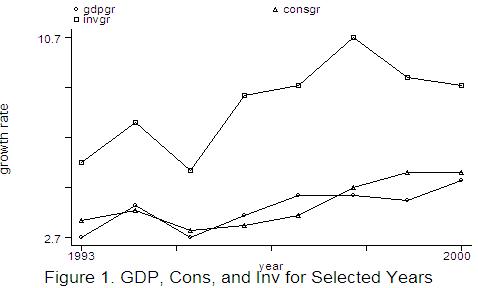
Finally, you
can combine graphs in a single figure. For example, suppose you would like
to obtain a graphical diagnostic on the relationship between GDP and consumption
growth rates, GDP and investment growth rates, GDP and productivity growth
rates, and revisit the relation between unemployment and inflation rates.
The commands to do that are as follows:
graph
gdpgr consgr, saving(part1)
graph
gdpgr invgr, saving(part2)
graph
gdpgr producgr, saving(part3)
graph
unemp inf, saving(part4)
graph
using part1 part2 part3 part4, margin(10)
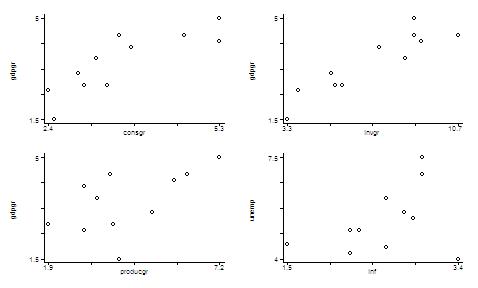
Through the
commands above, you generated and saved four individual graphs, and plotted
them into a single figure. The command margin(10) means that you
are requiring a space between each pair of graphs about 10% of the whole
picture. This is indeed a very useful tool to check pair wise correlation
among variables, before you run a regression.
Linear
Regression
As remarked
above, before running a regression, it is recommended to check the cross
correlation among covariates. You can do that graphically (see above) or
using the following simple command:
correlate
gdpgr gdpcapgr consgr invgr producgr unemp inf
(obs=11)
| gdpgr gdpcapgr consgr
invgr producgr unemp inf
---------+---------------------------------------------------------------
gdpgr | 1.0000
gdpcapgr
| 0.9890 1.0000
consgr | 0.8394 0.8347 1.0000
invgr | 0.9097 0.8841 0.8270
1.0000
producgr
| 0.5708 0.6003 0.7050
0.5238 1.0000
unemp | -0.3035 -0.4143 -0.4761 -0.3684 -0.5336
1.0000
inf | -0.1012 -0.1230 -0.1198 -0.3090 -0.0832
0.3590 1.0000
From the matrix
above you can see, for example, that GDP and GDP per capita growth rates
are closely related, but each of them has a different degree of connection
with unemployment rates. In fact, GDP per capita growth rates present higher
negative correlation with unemployment rates (41.43%) than total GDP growth
rates do (30.35%). Inflation and unemployment rates present a reasonable
degree of positive correlation (35.90%).
Now you start
with simple linear regressions. For example, let's check the individual
regressions of GDP with consumption and investment growth rates:
regress
gdpgr consgr
regress
gdpgr invgr
The output
will be
.
regress gdpgr consgr
Source | SS
df MS
Number of obs = 11
---------+------------------------------
F( 1, 9) = 21.46
Model | 7.78197201 1 7.78197201
Prob > F = 0.0012
Residual
| 3.26348251 9 .362609168
R-squared = 0.7045
---------+------------------------------
Adj R-squared = 0.6717
Total | 11.0454545 10 1.10454545
Root MSE = .60217
------------------------------------------------------------------------------
gdpgr | Coef. Std. Err.
t P>|t| [95%
Conf. Interval]
---------+--------------------------------------------------------------------
consgr | .8525216 .1840263
4.633 0.001 .4362251
1.268818
_cons | .3558076 .6949943
0.512 0.621 -1.216379
1.927994
------------------------------------------------------------------------------
.
regress gdpgr invgr
Source | SS
df MS
Number of obs = 11
---------+------------------------------
F( 1, 9) = 43.22
Model | 9.14164404 1 9.14164404
Prob > F = 0.0001
Residual
| 1.90381048 9 .211534498
R-squared = 0.8276
---------+------------------------------
Adj R-squared = 0.8085
Total | 11.0454545 10 1.10454545
Root MSE = .45993
------------------------------------------------------------------------------
gdpgr | Coef. Std. Err.
t P>|t| [95%
Conf. Interval]
---------+--------------------------------------------------------------------
invgr | .3969137 .0603774
6.574 0.000 .2603305
.5334969
_cons | .7032821 .4422039
1.590 0.146 -.2970526
1.703617
------------------------------------------------------------------------------
Please note
that you don't need to include the intercept, because STATA automatically
includes it. In the output above you have the main regression diagnostics
(ANOVA, adjusted R-squared, t-statistics, sample size, etc.). The same
rule apply to multiple linear regressions. For example, suppose you want
to find the main sources of GDP growth. You type:
regress
gdpgr consgr invgr producgr unemp inf
And the output
will be:
.
regress gdpgr consgr invgr producgr unemp
inf
Source | SS
df MS
Number of obs = 11
---------+------------------------------
F( 5, 5) = 7.27
Model | 9.70924721 5 1.94184944
Prob > F = 0.0242
Residual
| 1.33620731 5 .267241462
R-squared = 0.8790
---------+------------------------------
Adj R-squared = 0.7581
Total | 11.0454545 10 1.10454545
Root MSE = .51695
------------------------------------------------------------------------------
gdpgr | Coef. Std. Err.
t P>|t| [95%
Conf. Interval]
---------+--------------------------------------------------------------------
consgr | .1822094 .3605194
0.505 0.635 -.7445351
1.108954
invgr | .3448859 .1338048
2.578 0.050 .0009296
.6888422
producgr
| .0490201 .1547288
0.317 0.764 -.3487228
.4467631
unemp | .0551669 .1897954
0.291 0.783 -.4327176
.5430514
inf | .3019558 .372596
0.810 0.455 -.6558326
1.259744
_cons | -.8865854 1.492931 -0.594
0.578 -4.724287 2.951116
------------------------------------------------------------------------------
In the example
above, despite we have a high adjusted R-squared, most of the covariates
are not significant at 5% level (actually, only the investments coefficient
is significant at this level). There may be many problems in the regression
above. On the Econ 508 classes you will learn how to solve most of those
problems, including how to select the best specification for a model.
You can also
run a log-linear regression after transforming each variable into a natural
log scale. To do so, you type:
gen
lngdpgr=ln(gdpgr)
gen
lnconsgr=ln(consgr)
gen
lninvgr=ln(invgr)
gen
lnproduc=ln(producgr)
gen
lnunemp=ln(unemp)
gen
lninf=ln(inf)
regress
lngdpgr lnconsgr lninvgr lnproduc lnunemp lninf
Source | SS
df MS
Number of obs = 11
---------+------------------------------
F( 5, 5) = 7.19
Model | 1.07467131 5 .214934262
Prob > F = 0.0247
Residual
| .149400242 5 .029880048
R-squared = 0.8779
---------+------------------------------
Adj R-squared = 0.7559
Total | 1.22407155 10 .122407155
Root MSE = .17286
------------------------------------------------------------------------------
lngdpgr
| Coef. Std. Err.
t P>|t| [95%
Conf. Interval]
---------+--------------------------------------------------------------------
lnconsgr
| .114882 .4666926
0.246 0.815 -1.08479
1.314554
lninvgr
| .779761 .3081229
2.531 0.052 -.0122942
1.571816
lnproduc
| .0950277 .1935535
0.491 0.644 -.4025174
.5925728
lnunemp
| .2009322 .3716735
0.541 0.612 -.7544849
1.156349
lninf | .1184624 .2785439
0.425 0.688 -.5975574
.8344822
_cons | -.9912522 .787582
-1.259 0.264 -3.015796
1.033292
------------------------------------------------------------------------------
Finally, you
can generate predicted values of the dependent variable and of the residuals,
and plot them:
predict
lngdpfit
graph
lngdpfit year
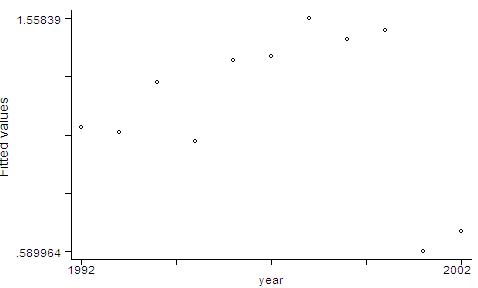
predict
lngdpres, resid
graph
lngdpres year
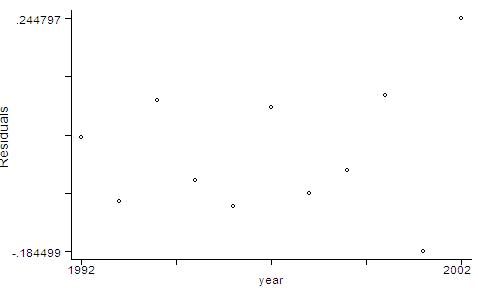
Linear
Hypothesis Testing
After running
the regressions above, we can proceed with tests of linear hypothesis on
the covariates. For example, suppose you would like to be sure that investment
growth "matters" to GDP growth. **(Please recall that you are no longer
performing causality tests, but only detecting whether the two variables
are correlated. Through the Econ 508 classes, you will learn how to perform
causality tests.)** Thus, you proceed with:
test
lninvgr
And the output
will be:
(
1) lninvgr = 0.0
F( 1, 5) = 6.40
Prob > F = 0.0525
You just performed
a F-test for the null hypothesis of lninvgr=0 against the alternative of
lninvgr ~= 0. The computed F-statistic is the squared of the popular t-statistic.
The result means that investment growth rates (in logs) are significantly
different than zero at 5.25% level, and therefore they contribute
to explain the variation in GDP growth rates (in logs).
To test the
joint significance of two or more covariates, you type:
test
lninvgr lnconsgr lnproduc
And the output
will be:
(
1) lninvgr = 0.0
(
2) lnconsgr = 0.0
(
3) lnproduc = 0.0
F( 3, 5) = 11.40
Prob > F = 0.0113
Here you
are testing the null hypothesis that all covariates are zero against the
alternative hypothesis that at least one of them is different than zero.
The result shows that we cannot accept the null at 1.13% of significance,
i.e., some of them are significantly different than zero at this level.
So, some of them "matter" in explaining the variation in GDP growth rates
(logs) along the years.
You could
also extend your tests and check the equality of covariates. For example,
suppose you would like to know if investments and consumption have similar
coefficients:
test
lninvgr=lnconsgr
The output
will be:
(
1) - lnconsgr + lninvgr = 0.0
F( 1, 5) = 0.79
Prob > F = 0.4143
This is similar
to test whether their difference is zero (null hypothesis) or different
than zero (alternative). The conclusion is that, at 5% significance level,
we cannot reject the null hypothesis of similarity.
|
